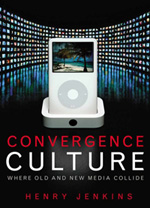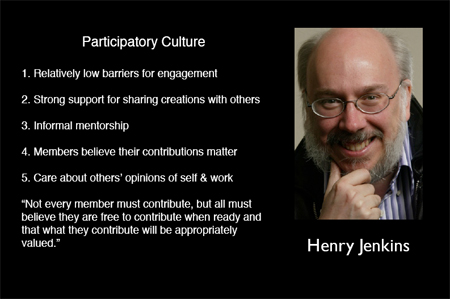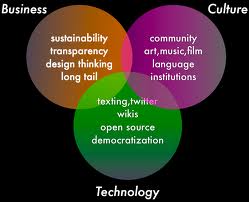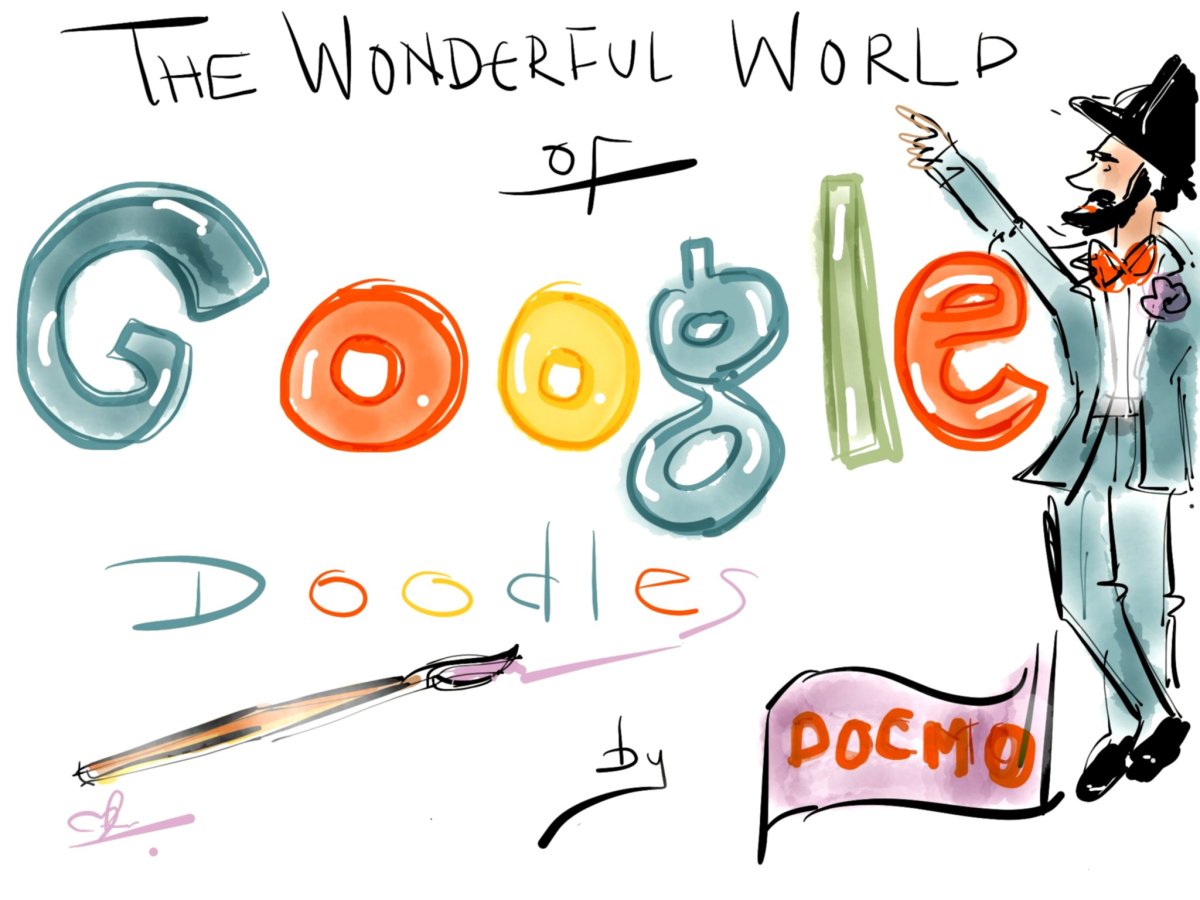Henry Jenkins - Convergence Culture

Preface
My husband has been an educator all of his life. He recently entered a program to pursue his PhD in Educational Technology and Leadership. As you can imagine, this requires considerable self discipline and hard work.
In a recent class, he was required to read a book titled, Convergence Culture, by Henry Jenkins, and then write a book review. Once he finished his notes and review of the book, he asked me to type it for him. Being a professional secretary, I had no qualms in doing this.
As I typed, I found myself fascinated by the report. It was so captivating that I had to read the book for myself. It was fascinating! I considered writing my own “report” but then realized that my husband had done such a splendid job; I should just share what he had already written.
So, I offer this book review by a “guest hubber.” I hope you will find the review as captivating as I did, and maybe read the book for yourself.
Convergence Culture
Jenkins, Henry. Convergence Culture: Where Old and New Media Collide. New York; New York
University Press, 2006
Published in 2006, Convergence Culture: Where Old and New Media Collide, is a look back at differing types of media and the technology used to deliver that media. How both media and technology have changed the culture we take for granted today.
In his introduction, Henry Jenkins explains, "old media never die -- and they don't even necessarily fade away; what dies are simply the tools we use to access media content." (Jenkins, 13)
He cites the transition from 8-track tape to Beta; records to CD's and MP3 files. Each of these methods of media distribution is associated with a cultural-timeframe within American History. Jenkins shows readers the way in which society has converged with business, entertainment, social and religious aspects of society throughout history as media context has changed.
Although Convergence Culture is based on the idea that everyone has a right to contribute to their culture through participation, Jenkins feels that the introduction of the Internet has blurred the lines of traditional media acquisition and sharing. Therefore, culture is no longer limited to a region but has spread throughout the modern world.
Jenkins attributes the cultural convergence phenomenon to “collective intelligence” and “participatory culture”, such as, fan fiction, spoiling, and blogging websites. He sheds a great deal of light on the aspects of technological convergence and economic convergence. "Technological convergence," is the digitization of media content, while "Economic convergence" refers to integrating entertainment in such a way that media conglomerates control a variety of media production, cultural production and transmedia portals.


Collective Intelligence
Consumer creativity has produced today’s cultural convergence through their interaction with television shows like American Idol, movies like The Matrix, and online spoiler communities spawned by such shows as Survivor, not-to-mention, fan fiction sites inspired by books like Harry Potter. This interaction of consumers created what Jenkins calls the collective intelligence, in which no one person knows everything, but everyone knows something. As individuals share the knowledge they have, the community as a whole, gains a vast wealth of information.
The concept of collective intelligence stands in contrast to the expert paradigm. These rules about how you access and process information, rules that are established through traditional disciplines. As Jenkins explains, “By contrast, the strengths and weakness of collective intelligence is that it is disorderly, undisciplined, and unruly.” (Jenkins 53) “What holds collective intelligence together is not the passion of knowledge – which is relatively static, but the social process of acquiring knowledge – which is dynamic and participatory, continually testing and reaffirming the group’s social ties.” (Jenkins 54) Jenkins goes on to say, “Emerging knowledge cultures are voluntary, temporary, and tactical affiliations. People only remain in these intelligence groups as long as they meet the emotional and intellectual needs of the individual.” (Jenkins 57)
Jenkins writes about cultural icons such as American Idol, FOX, and Coca-Cola, and their media manipulation. He analyzes how viewers are encouraged to participate in the outcome of American Idol through the use of websites and cell phones to vote for their favorite contestant. However, viewers perceived, and then responded negatively, to what they felt was over commercialism and maneuvering behind-the-scenes of prominent business sponsors.

Interactive technology
In the chapter dealing with the Matrix franchise, Jenkins shares his concept of transmedia as the implementation of a cultural phenomenon through a number of media forms. The Matrix is a prime example. Film, digital games, and websites work together to create the complete Matrix experience as not all information about the Matrix is shared in a single media form. To get the full understanding of the Matrix, consumers must collect information offered in digital games, on websites, and in the movies. Unfortunately, this alienated large segments of people who attended the movies only for the entertainment value, and left feeling dazed and confused.
Interactive technology is a means by which consumers are given the ability to be more responsive; however, how responsive they can be is limited. A television allows the consumer to interact by changing the channel, digital video recorders allow the consumer to choose when to view a recorded program, and video games allow the consumer more in depth options of interaction. The participation of consumers is the key in convergence culture. Jenkins makes that clear when he says, “Allowing consumers to interact with media under controlled circumstances is one thing; allowing them to participate in the production and distribution of cultural goods – on their own terms – is something else altogether.” (Jenkins, 133)
Problems have arisen in this participatory culture between corporations seeking to regulate and criminalize many forms of fan participation, and those viewing fans as possible collaborators in the production and promotion of their franchises. Jenkins expounds on the conundrum corporate marketers find themselves in when he says, “Marketers have turned our children into walking, talking billboards who wear logos on their T-shirts, sew patches on their backpacks, plaster stickers on their lockers, hang posters on their walls, but they must not, under penalty of law, post them on their home pages.” (Jenkins, 138) The most intense clash between media franchises and media consumers were, of course, Napster and the Warner Bros. purchase of the Harry Potter film rights.
Through detailed examples, Jenkins shares how media production, distribution, and consumption are changing our culture. Unfortunately, he only briefly touches on the possibilities of media convergence in education. Student produced websites that encourage participation and social interaction are cited as informal means of collective intelligence. However, most schools do not share this same view. Jenkins makes this point when he says, “ So far, our schools are still focused on generating autonomous learners; to seek information from others is still classified as cheating.-- we are living more and more within knowledge cultures based on collective intelligence. Our schools are not teaching what it means to live and work in such knowledge communities, but popular culture may be doing so.” (Jenkins, 129) He goes on to say, “In a hunting culture, kids play with bows and arrows. In an information society, they play with information.” (Jenkins, 130)
In the final chapter, Jenkins touches on how media convergence has filtered into the political arena as candidates now use the web to raise campaign funds and spread their political platforms.
He closes with the acknowledgement that media and its methods of delivery are rapidly changing and encourages readers to rethink the goals of cultural education, as he explains the power of convergence culture lies within its participants.
I found this book to be informative in a retrospective way, as media and culture are constantly changing. It was fascinating to see just how far, and how quickly, information technology has progressed in society, and the profound changes it has brought. It also sparked my interest as to how to incorporate various types of technology, and collective intelligence into education.
I would highly recommend this book to anyone interested in the ever emerging world of technology and its many uses.









